The Holocaust (WWII)
(German Occupied Europe – 1941-1945)

Richard Baer (1911-1963)
(Auschwitz I Camp Commandant, 1944-1945)

Richard Baer (9 September 1911 – 17 June 1963) was a German SS officer who, among other assignments, was the commandant of Auschwitz I concentration camp from May 1944 to February 1945, and right after, from February to April 1945, commandant of Mittelbau-Dora concentration camp . Following the war, Baer lived under an assumed name to avoid prosecution but was recognized and arrested in December 1960. He died in detention before he could stand trial.
Role in the Holocaust
Baer signed on with the Nazi Party in 1930, and on 1 July 1932 he became a member of the General SS. In the local SS post, in Weiden, he met the future concentration camp commandant Martin Gottfried Weiss. Under the direction of Weiss, the small SS gang was used to offer on weekends speaker protection at the public meetings of the Nazi Party in the surrounding villages. Baer later stated that he had joined the General SS because he liked the “soldier discipline” and the “joy of playing soldiers”.
After the Nazi came to power, most of the SS men in Weiden served as auxiliary police officers locally, and, as early as mid-April 1933, they were assigned as guards to the Dachau concentration camp, where Baer was subjected to military drills, Nazi ideological indoctrination, and hard training on techniques of systematic terror against the prisoners. His teacher was Theodor Eicke, the camp commandant since June 1933 and shaper of the Nazi concentration camp system, the so-called “Dachau Model”. Baer described the training for guard duty in Dachau as “very strict” and as being “sharply polished” there: “The more we were polished, the more proud we were of it”.
From December 1934 to end-March 1935, Baer performed guard duty at the infamous Gestapo prison called Columbia-Haus in Berlin. He was later assigned to the SS-Death’s Head (SS-TV) 2nd regiment Brandenburg, which in 1936 was involved in the build up of the Sachsenhausen concentration camp. After taking a platoon commander course in Oranienburg concentration camp, Baer served, from March to September 1938, with the SS-TV 3rd regiment Thuringen in Buchenwald concentration camp. In September 1938, Baer was promoted to SS-second lieutenant (Untersturmführer), and, at the end of the same year, he headed the first group of guards in the newly established Neuengamme concentration camp, then still a sub-camp of the Sachsenhausen concentration camp. In September 1940 became a commando overseer.
At the end of 1940, Baer asked to reach the front line, and, after completing a course to become company commander, he was sent to the eastern front. In December 1941, as a result of a wound, he was transferred back to Neuengamme concentration camp.
In 1942 Baer was appointed adjutant to the commandant of the Neuengamme concentration camp. At Neuengamme he participated in the killing of Soviet prisoners of war in a special gas chamber and in the selection of prisoners for the so-called Operation 14f13 in the T4 Euthanasia Program.
From November 1942 to May 1944, Baer was adjutant to Oswald Pohl, then chief of the SS Main Economic and Administrative Office. In November 1943, he took over the office DI (Central Office) in the Department D “Concentration camps Inspectorate”. He succeeded Arthur Liebehenschel, considered by Himmler to be too “soft” with the prisoners, as the third and final commandant of Auschwitz I from 11 May 1944, until the final dissolution of the camp in early 1945.
From November 1943 until the end of 1944 Fritz Hartjenstein and Josef Kramer were responsible for the extermination camp in Auschwitz II-Birkenau, so that Baer was only Commandant of this part of the camp from the end of 1944 until February 1945. Near the end of the war Richard Baer, having replaced Otto Förschner as commandant of the Mittelbau-Dora concentration camp in Nordhausen, was responsible for the execution of Soviet prisoners at mass gallows. His final rank was SS Major.
Source: Wikipedia
False Flag
A false flag is a covert operation designed to deceive; the deception creates the appearance of a particular party, group, or nation being responsible for some activity, disguising the actual source of responsibility.
3.7a – Richard Baer
(Auschwitz I Camp Commandant, 1944-45)
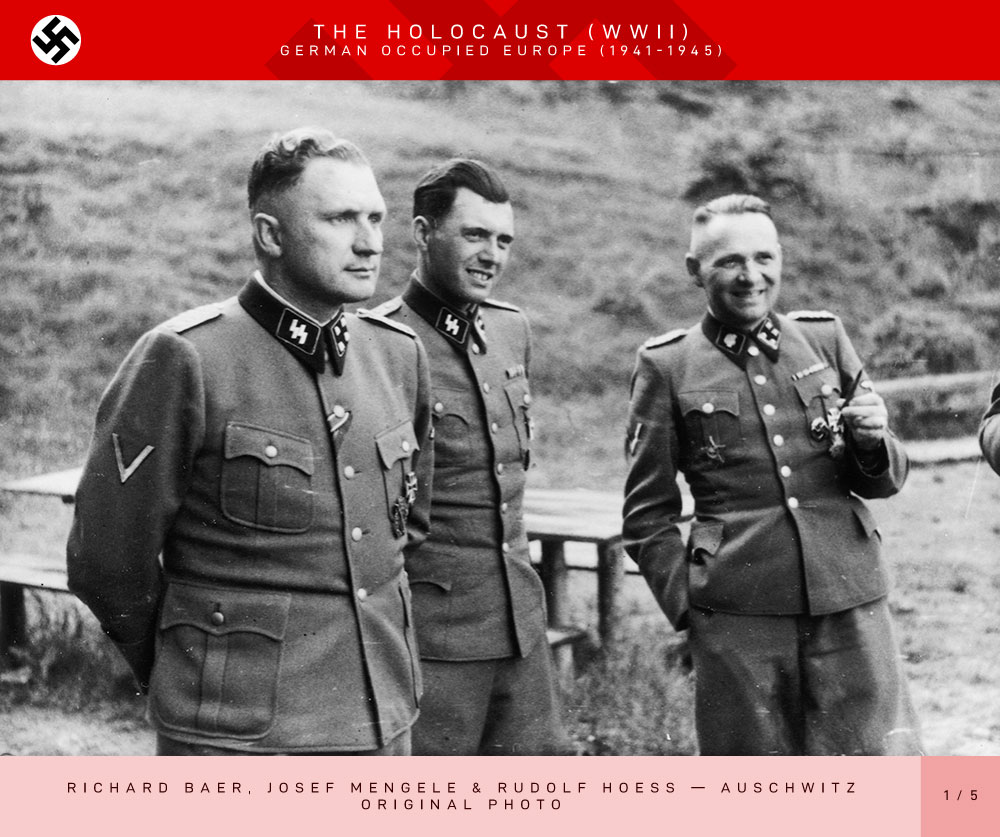
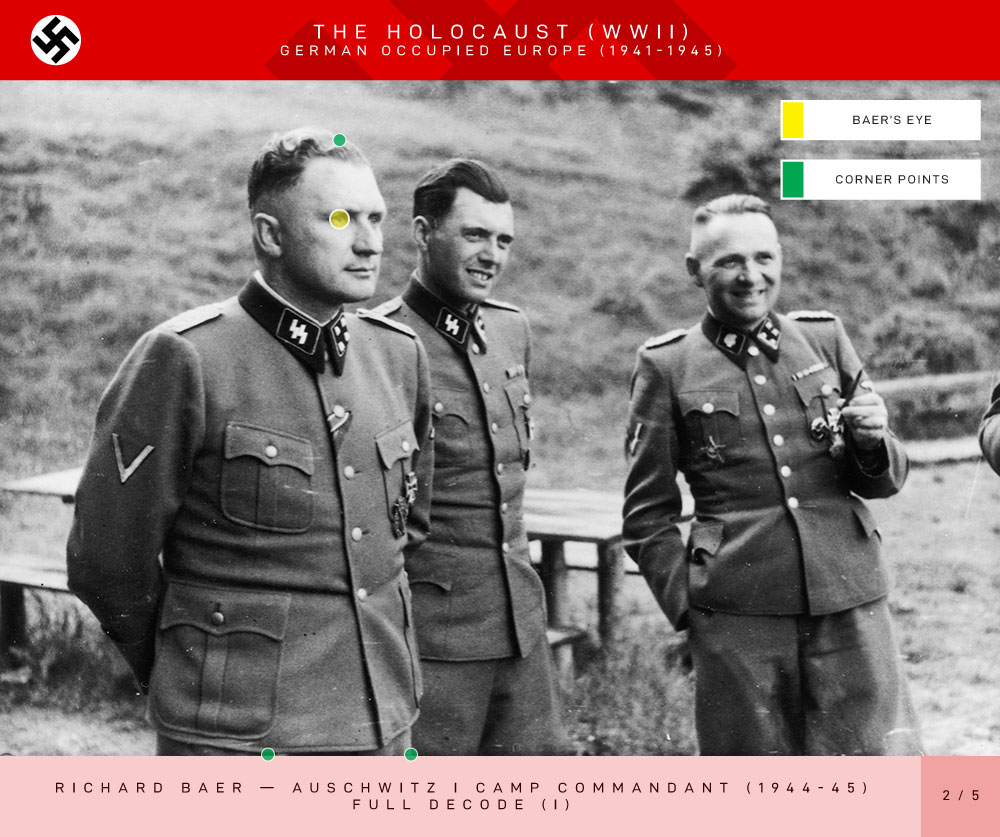

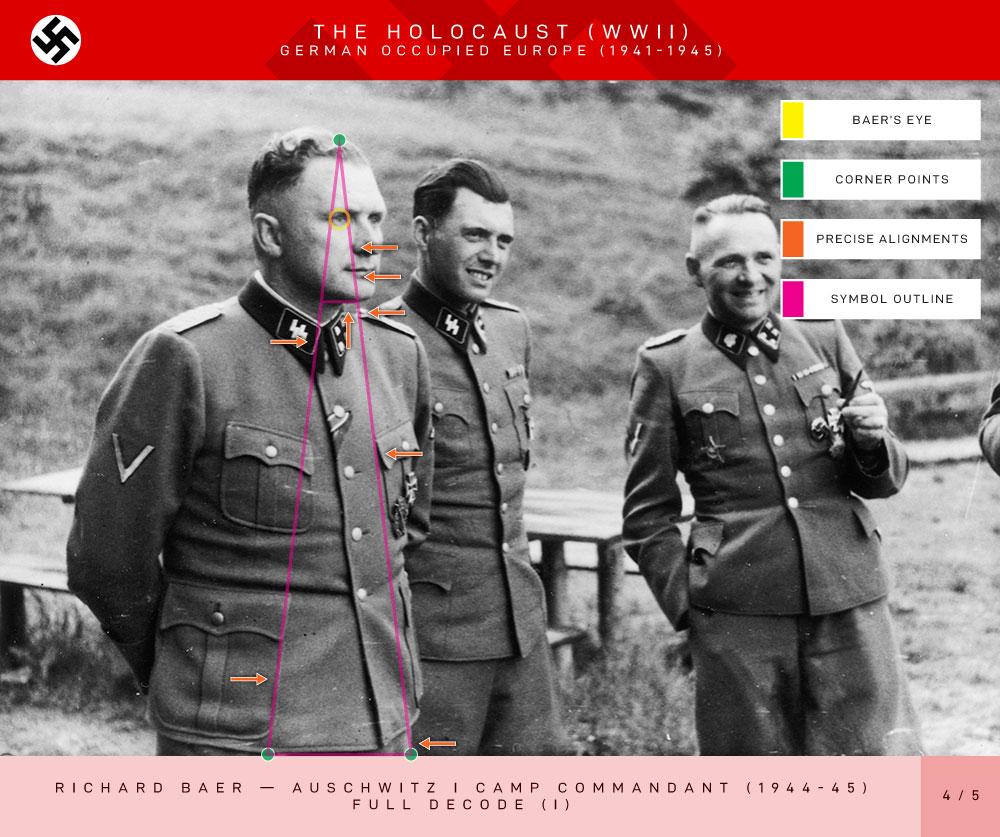
Subliminal Symbolism (I)
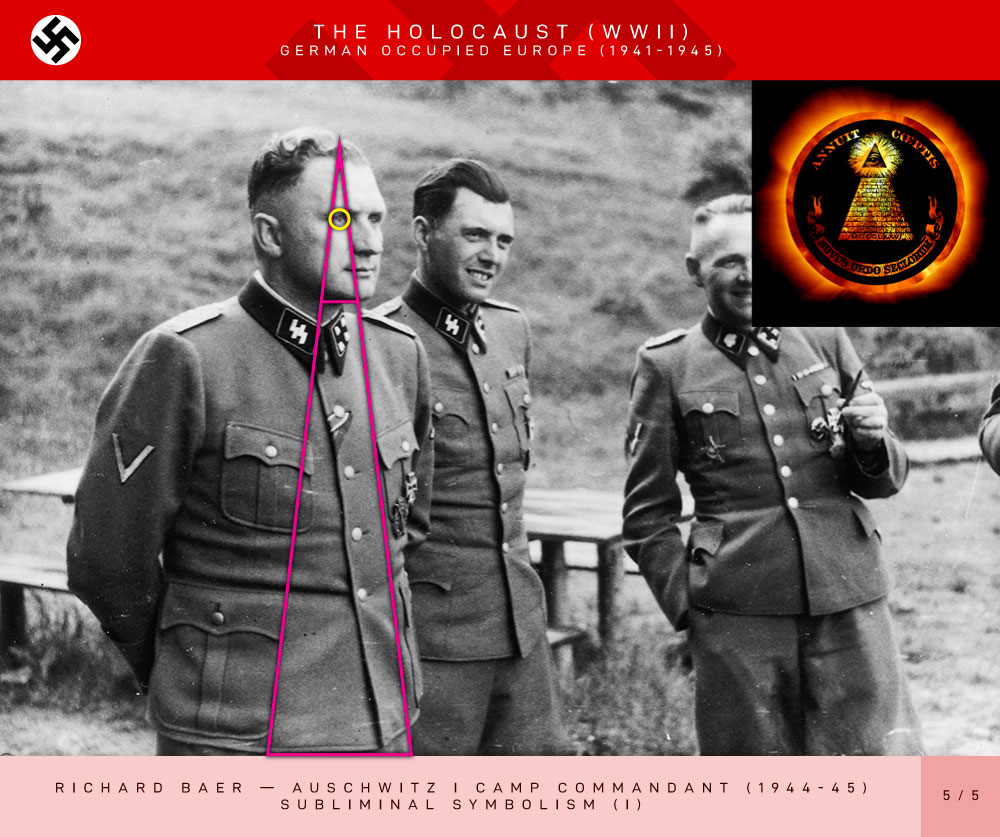
Josef Mengele (1911-1979)
(SS Officer and Auschwitz Physician)

Josef Mengele (16 March 1911 – 7 February 1979), also known as the Angel of Death (German: Todesengel) was a German Schutzstaffel (SS) officer and physician during World War II. He is mainly remembered for his actions at the Auschwitz concentration camp, where he performed deadly experiments on prisoners, and was a member of the team of doctors who selected victims to be killed in the gas chambers and was one of the doctors who administered the gas. With Red Army troops sweeping through Poland, Mengele was transferred 280 kilometres (170 mi) from Auschwitz to the Gross-Rosen concentration camp on 17 January 1945, just 10 days before the arrival of the Soviet forces at Auschwitz.
Before the war, Mengele had received doctorates in anthropology and medicine, and began a career as a researcher. He joined the Nazi Party in 1937 and the SS in 1938. He was assigned as a battalion medical officer at the start of World War II, then transferred to the Nazi concentration camps service in early 1943 and assigned to Auschwitz, where he saw the opportunity to conduct genetic research on human subjects. His experiments focused primarily on twins, with no regard for the health or safety of the victims.
After the war, Mengele fled to South America. He sailed to Argentina in July 1949, assisted by a network of former SS members. He initially lived in and around Buenos Aires, then fled to Paraguay in 1959 and Brazil in 1960, all the while being sought by West Germany, Israel, and Nazi hunters such as Simon Wiesenthal, who wanted to bring him to trial. Mengele eluded capture in spite of extradition requests by the West German government and clandestine operations by the Israeli intelligence agency Mossad. He drowned in 1979 after suffering a stroke while swimming off the coast of Bertioga, and was buried under the false name of Wolfgang Gerhard. His remains were disinterred and positively identified by forensic examination in 1985.
Auschwitz
In 1942 Auschwitz II (Birkenau), originally intended to house slave laborers, began to be used instead as a combined labor camp and extermination camp. Prisoners were transported there by rail from all over German-occupied Europe, arriving in daily convoys. By July 1942, SS doctors were conducting “selections” where incoming Jews were segregated, and those considered able to work were admitted into the camp while those deemed unfit for labor were immediately killed in the gas chambers. The arrivals that were selected to die, about three quarters of the total, included almost all children, women with small children, pregnant women, all the elderly, and all of those who appeared (in a brief and superficial inspection by an SS doctor) to be not completely fit and healthy.
In early 1943, encouraged by von Verschuer, Mengele applied to transfer to the concentration camp service. His application was accepted and he was posted to Auschwitz, where he was appointed by SS-Standortarzt Eduard Wirths, chief medical officer at Auschwitz, to the position of chief physician of the Zigeunerfamilienlager (Romani family camp) at Birkenau, a subcamp located on the main Auschwitz complex. The SS doctors did not administer treatment to the Auschwitz inmates, but supervised the activities of inmate doctors who had been forced to work in the camp medical service. As part of his duties, Mengele made weekly visits to the hospital barracks and ordered any prisoners who had not recovered after two weeks in bed to be sent to the gas chambers.
Mengele’s work also involved carrying out selections, a task that he chose to perform even when he was not assigned to do so, in the hope of finding subjects for his experiments, with a particular interest in locating sets of twins. In contrast to most of the other SS doctors, who viewed selections as one of their most stressful and unpleasant duties, he undertook the task with a flamboyant air, often smiling or whistling a tune. He was one of the SS doctors responsible for supervising the administration of Zyklon B, the cyanide-based pesticide that was used for the mass killings in the Birkenau gas chambers. He served in this capacity at the gas chambers located in crematoria IV and V.
When an outbreak of noma—a gangrenous bacterial disease of the mouth and face—struck the Romani camp in 1943, Mengele initiated a study to determine the cause of the disease and develop a treatment. He enlisted the assistance of prisoner Berthold Epstein, a Jewish pediatrician and professor at Prague University. The patients were isolated in a separate barracks and several afflicted children were killed so that their preserved heads and organs could be sent to the SS Medical Academy in Graz and other facilities for study. This research was still ongoing when the Romani camp was liquidated and its remaining occupants killed in 1944.
When a typhus epidemic began in the women’s camp, Mengele cleared one block of six hundred Jewish women and sent them to their deaths in the gas chambers. The building was then cleaned and disinfected and the occupants of a neighboring block were bathed, de-loused and given new clothing before being moved into the clean block. This process was repeated until all of the barracks were disinfected. Similar procedures were used for later epidemics of scarlet fever and other diseases, with infected prisoners being killed in the gas chambers. For these actions, Mengele was awarded the War Merit Cross (Second Class with swords) and was promoted in 1944 to First Physician of the Birkenau subcamp.
Human experimentation
Mengele used Auschwitz as an opportunity to continue his anthropological studies and research into heredity, using inmates for human experimentation. His medical procedures showed no consideration for the health, safety, or physical and emotional suffering of the victims. He was particularly interested in identical twins, people with heterochromia iridum (eyes of two different colors), dwarfs, and people with physical abnormalities. A grant was provided by the Deutsche Forschungsgemeinschaft (German Research Foundation), at the request of von Verschuer, who received regular reports and shipments of specimens from Mengele. The grant was used to build a pathology laboratory attached to Crematorium II at Auschwitz II-Birkenau. Dr. Miklós Nyiszli, a Hungarian Jewish pathologist who arrived in Auschwitz on 29 May 1944, performed dissections and prepared specimens for shipment in this laboratory. The twin research was in part intended to prove the supremacy of heredity over environment and thus strengthen the Nazi premise of the genetic superiority of the Aryan race. Nyiszli and others reported that the twin studies may also have been motivated by an intention to increase the reproduction rate of the German race by improving the chances of racially desirable people having twins.
Mengele’s research subjects were better fed and housed than the other prisoners, and temporarily spared from execution in the gas chambers. His research subjects lived in their own barracks, where they were provided with a marginally better quality of food and somewhat improved living conditions than the other areas of the camp. When visiting his young subjects, he introduced himself as “Uncle Mengele” and offered them sweets, while at the same time being personally responsible for the deaths of an unknown number of victims whom he killed via lethal injection, shootings, beatings, and his deadly experiments. In his 1986 book, Lifton describes Mengele as sadistic, lacking empathy, and extremely antisemitic, believing the Jews should be eliminated entirely as an inferior and dangerous race. Rolf Mengele later claimed that his father had shown no remorse for his wartime activities.
A former Auschwitz inmate doctor said of Mengele:
He was capable of being so kind to the children, to have them become fond of him, to bring them sugar, to think of small details in their daily lives, and to do things we would genuinely admire … And then, next to that, … the crematoria smoke, and these children, tomorrow or in a half-hour, he is going to send them there. Well, that is where the anomaly lay.
Twins were subjected to weekly examinations and measurements of their physical attributes by Mengele or one of his assistants. The experiments he performed on twins included unnecessary amputation of limbs, intentionally infecting one twin with typhus or some other disease, and transfusing the blood of one twin into the other. Many of the victims died while undergoing these procedures, and those who survived the experiments were sometimes killed and their bodies dissected once Mengele had no further use for them. Nyiszli recalled one occasion on which Mengele personally killed fourteen twins in one night by injecting their hearts with chloroform. If one twin died from disease, he would kill the other twin to allow comparative post-mortem reports to be produced for research purposes.
Mengele’s eye experiments included attempts to change the eye color by injecting chemicals into the eyes of living subjects, and he killed people with heterochromatic eyes so that the eyes could be removed and sent to Berlin for study. His experiments on dwarfs and people with physical abnormalities included taking physical measurements, drawing blood, extracting healthy teeth, and treatment with unnecessary drugs and X-rays. Many of his victims were dispatched to the gas chambers after about two weeks, and their skeletons sent to Berlin for further analysis. Mengele sought out pregnant women, on whom he would perform experiments before sending them to the gas chambers. Alex Dekel, a survivor, reports witnessing Mengele performing vivisection without anesthesia, removing hearts and stomachs of victims. Yitzhak Ganon, another survivor, reported in 2009 how Mengele removed his kidney without anesthesia. He was forced to return to work without painkillers. Witness Vera Alexander described how Mengele sewed two Romani twins together, back to back, in a crude attempt to create conjoined twins; both children died of gangrene after several days of suffering.
Source: Wikipedia
3.7b – Josef Mengele “The Angel of Death”
(Human Medical Experimentation, Auschwitz)

Subliminal Symbolism (II)
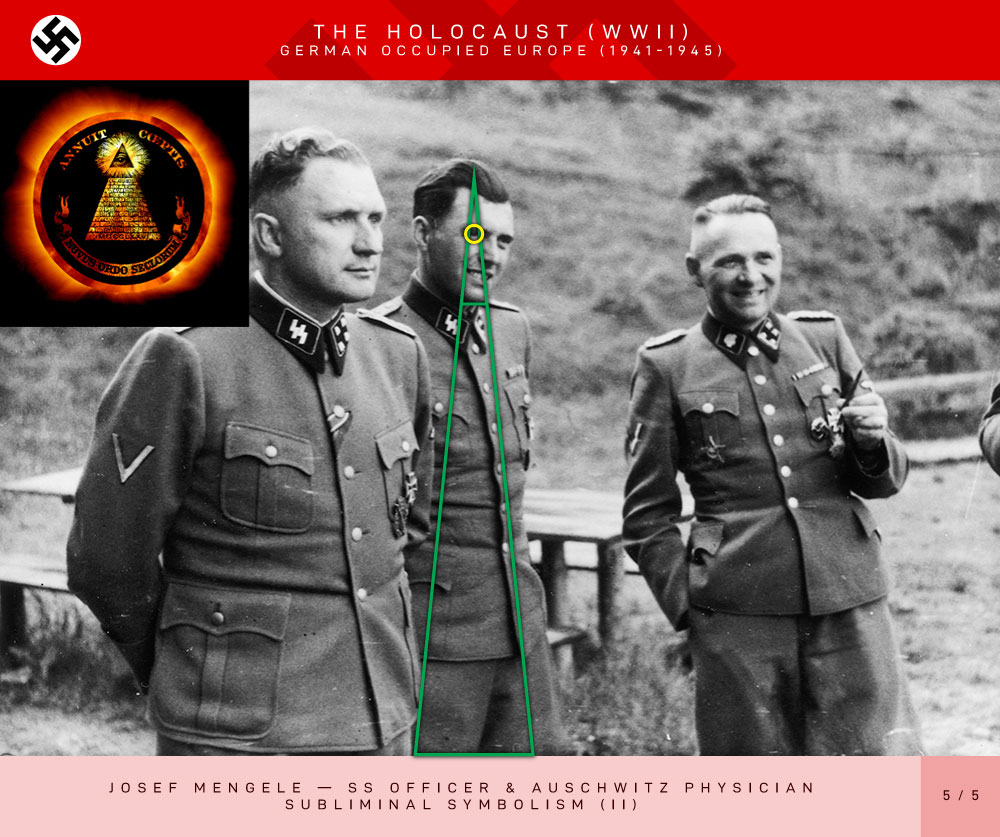
Rudolf Hoss (1901-1947)
(Auschwitz Camp Commandant, 1940-1943 & 1944-1945)

Rudolf Franz Ferdinand Höss (also Höß, Hoeß or Hoess; 25 November 1901 – 16 April 1947) was a German SS officer during the Nazi era who, after the defeat of Nazi Germany, was convicted for war crimes. Höss was the longest-serving commandant of Auschwitz concentration and extermination camp (from 4 May 1940 to November 1943, and again from 8 May 1944 to 18 January 1945). He tested and implemented means to accelerate Hitler’s order to systematically exterminate the Jewish population of Nazi-occupied Europe, known as the Final Solution. On the initiative of one of his subordinates, Karl Fritzsch, Höss introduced the pesticide Zyklon B to be used in gas chambers, where more than a million people were killed.
Höss was hanged in 1947 following a trial before the Polish Supreme National Tribunal. During his imprisonment, at the request of the Polish authorities, he wrote his memoirs, released in English under the title Commandant of Auschwitz: The Autobiography of Rudolf Hoess.
Auschwitz command
On 1 May 1940, Höss was appointed commandant of a prison camp in western Poland, a territory Germany had incorporated into the province of Upper Silesia. The camp was built around an old Austro-Hungarian (and later Polish) army barracks near the town of Oświęcim; its German name was Auschwitz. Höss commanded the camp for three and a half years, during which he expanded the original facility into a sprawling complex known as Auschwitz-Birkenau concentration camp. Höss had been ordered “to create a transition camp for ten thousand prisoners from the existing complex of well-preserved buildings,” and he went to Auschwitz determined “to do things differently” and develop a more efficient camp than those at Dachau and Sachsenhausen where he had previously served. Höss lived at Auschwitz in a villa with his wife and five children.
The earliest inmates at Auschwitz were Soviet prisoners-of-war and Polish prisoners, including peasants and intellectuals. Some 700 arrived in June 1940, and were told they would not survive more than three months. At its peak, Auschwitz comprised three separate facilities: Auschwitz I, Auschwitz II-Birkenau and Auschwitz III-Monowitz. These included many satellite sub-camps, and the entire camp was built on about 8,000 hectares (20,000 acres) that had been cleared of all inhabitants. Auschwitz I was the administrative centre for the complex; Auschwitz II Birkenau was the extermination camp where most of the murders were committed; and Auschwitz III Monowitz was the slave-labour camp for I.G. Farbenindustrie AG, and later other German industries. The main purpose of Monowitz was the production of buna, a form of synthetic rubber.
Mass murder
In June 1941, according to Höss’s trial testimony, he was summoned to Berlin for a meeting with Himmler “to receive personal orders”. Himmler told Höss that Hitler had given the order for the “Final solution”. According to Höss, Himmler had selected Auschwitz for the extermination of Europe’s Jews “on account of its easy access by rail and also because the extensive site offered space for measures ensuring isolation”. Himmler described the project as a “secret Reich matter” and told Höss not to speak about it with SS-Gruppenführer Richard Glücks, head of the Nazi camp system run by the Death’s Head Unit. Höss said that “no one was allowed to speak about these matters with any person and that everyone promised upon his life to keep the utmost secrecy”. He told his wife about the camp’s purpose only at the end of 1942, since she already knew about it from Fritz Bracht. Himmler told Höss that he would be receiving all operational orders from Adolf Eichmann, who arrived at the camp four weeks later.
Höss began testing and perfecting techniques of mass murder on 3 September 1941. His experiments led to Auschwitz becoming the most efficiently murderous instrument of the Final Solution and the Holocaust’s most potent symbol. According to Höss, during standard camp operations, two or three trains carrying 2,000 prisoners each would arrive daily for four to six weeks. The prisoners were unloaded in the Birkenau camp; those fit for labour were marched to barracks in either Birkenau or one of the Auschwitz camps, while those unsuitable for work were driven into the gas chambers. At first, small gassing bunkers were located deep in the woods to avoid detection. Later, four large gas chambers and crematoria were constructed in Birkenau to make the killing process more efficient, and to handle the increasing rate of extermination.
Technically [it] wasn’t so hard—it would not have been hard to exterminate even greater numbers…. The killing itself took the least time. You could dispose of 2,000 head in half an hour, but it was the burning that took all the time. The killing was easy; you didn’t even need guards to drive them into the chambers; they just went in expecting to take showers and, instead of water, we turned on poison gas. The whole thing went very quickly.
Höss experimented with various gassing methods. According to Eichmann’s trial testimony in 1961, Höss told him that he used cotton filters soaked in sulfuric acid for early killings. Höss later introduced hydrogen cyanide (prussic acid), produced from the pesticide Zyklon B, to the process of extermination, after his deputy Karl Fritzsch had tested it on a group of Russian prisoners in 1941. With Zyklon B, he said that it took 3–15 minutes for the victims to die and that “we knew when the people were dead because they stopped screaming.”
In 1942, Höss had an affair with an Auschwitz inmate, a political prisoner named Eleonore Hodys (or Nora Mattaliano-Hodys). The woman became pregnant, and was imprisoned in a standing-only arrest cell. Released from the arrest, she had an abortion in a camp hospital in 1943 and, according to her later testimony, just barely evaded being selected to be killed. The affair may have led to Höss’s recall from the Auschwitz command in 1943. SS judge Georg Konrad Morgen and his assistant Wiebeck investigated the case in 1944, interviewed Hodys and Höss and intended to proceed against Höss, but the case was dismissed. Morgen, Wiebeck and Hodys gave testimony after the war.
After being replaced as the Auschwitz commander by Arthur Liebehenschel, on 10 November 1943, Höss assumed Liebehenschel’s former position as the head of Amt D I in Amtsgruppe D of the SS Main Economic and Administrative Office (WVHA); he also was appointed deputy of the inspector of the concentration camps under Richard Glücks.
Operation Höss
On 8 May 1944, Höss returned to Auschwitz to supervise Operation Höss, in which 430,000 Hungarian Jews were transported to the camp and killed in 56 days between May and July. Even Höss’ expanded facility could not handle the huge number of victims’ corpses, and the camp staff were obliged to dispose of thousands of bodies by burning them in open pits.
Ravensbrück
Höß concluded his murderous career in Ravensbrück concentration camp. He moved there in November 1944 with his family who lived close by. After the completion of the gas chamber, Höß coordinated the operations of killing by gassing there with a dead toll of more than 2000 female prisoners.
Source: Wikipedia
3.7c – Rudolf Hoss
(Auschwitz Camp Commandant, 1940-1943 & 1944-1945)
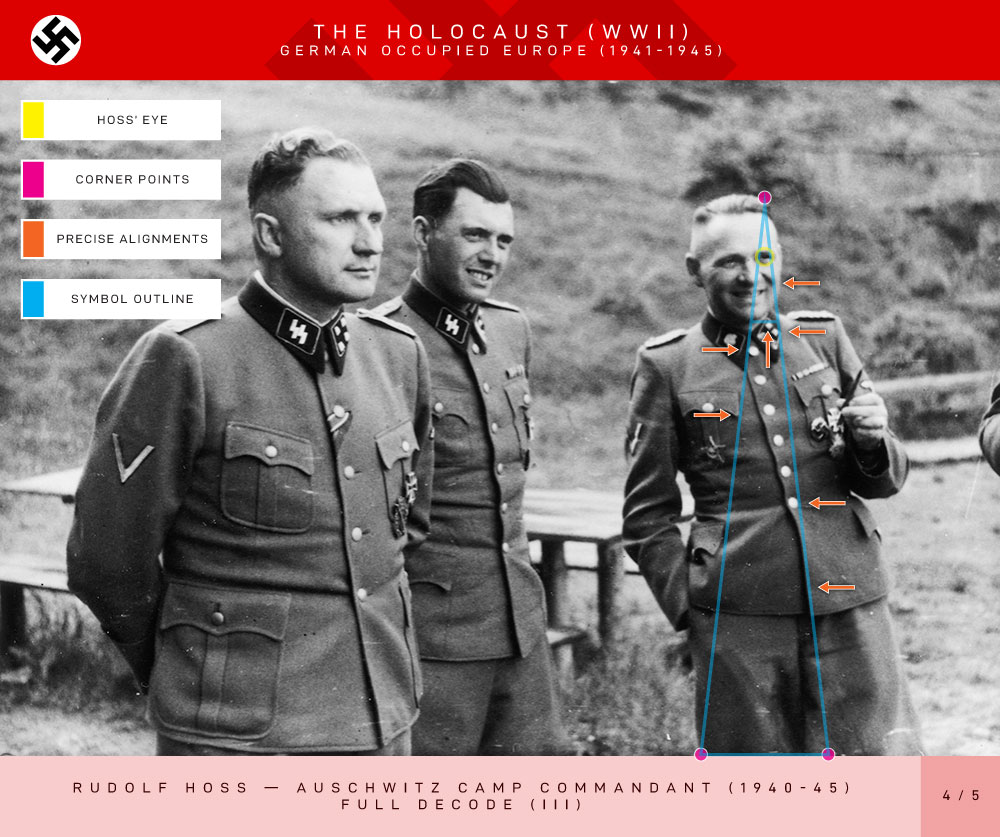
Subliminal Symbolism (III)
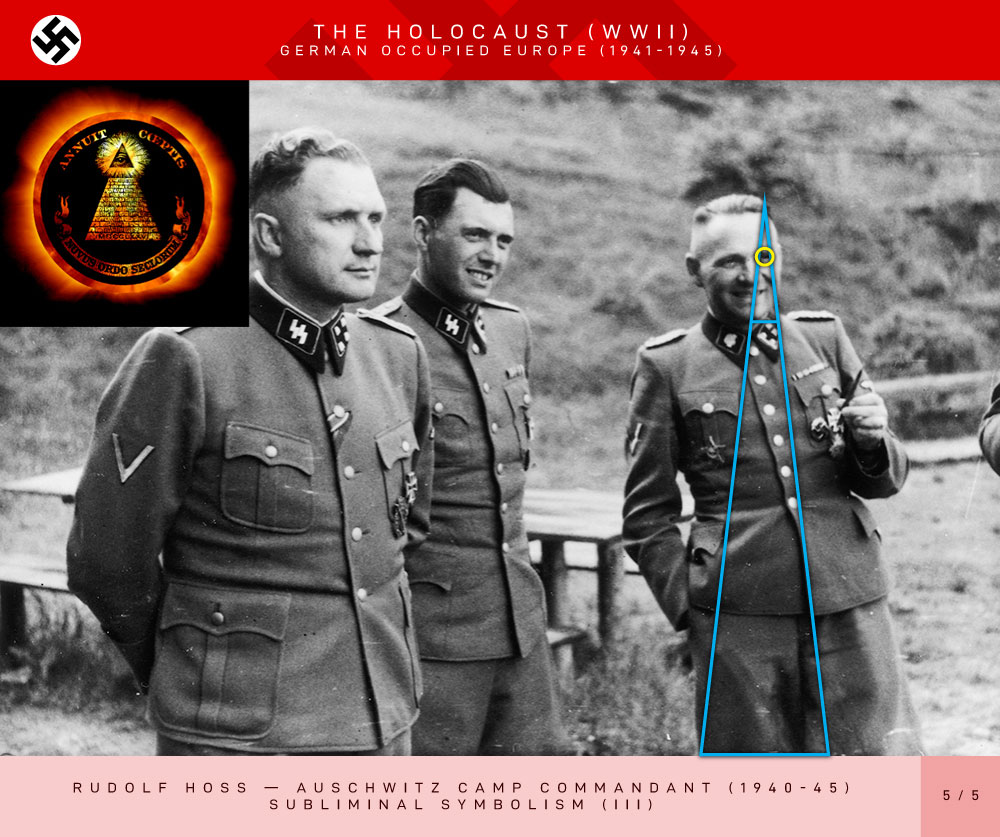


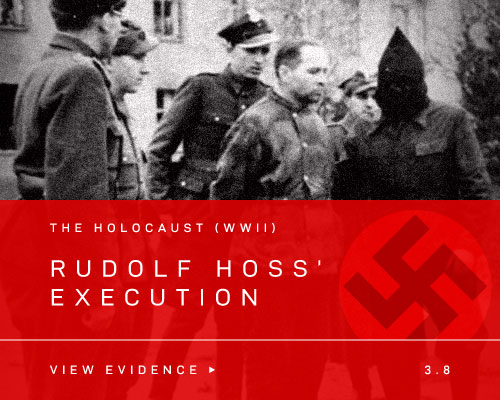
You must be logged in to post a comment.